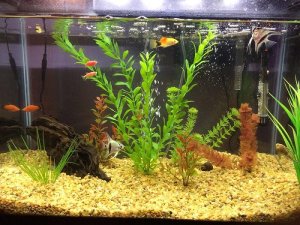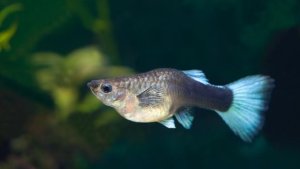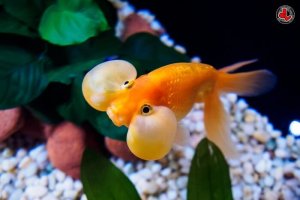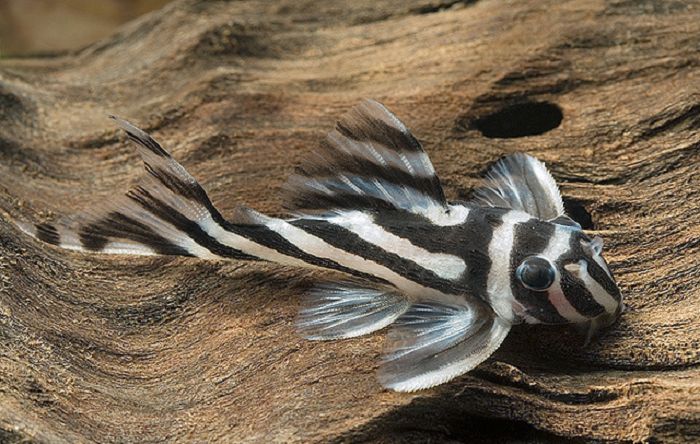
The Zebra Pleco is a rare and expensive Pleco Fish or algae eater that is endemic to a small stretch of the Xingu River in Brazil. Did you know, all Pleco fish are actually a type of Catfish? Endangered in the wild, the Brazilian government has currently banned its export, and the fact it is not easy to breed quickly means it is a sought-after fish for many hobbyists.
However, despite its rarity, it’s actually relatively easy to keep. Therefore, if you do manage to obtain one of these striking little Pleco fish, this guide will show you how to look after them and what to do.
Breed Overview
| Origin | Xingu River, Brazil |
| Lifespan | 10-15 years |
| Size | 3-4” or 5-7 cm |
| Colors | Black and white stripes |
| Food | Mostly vegetarian |
| Tank Size | Minimum 30 gallons or 114 liters |
| Temperament | Shy, peaceful, easy to take care of |
| Water type | Freshwater |
| Water Temperature | 78-84 F or 22-28 C |
| Water pH | 7 |
Appearance
The Zebra Pleco gets its name from it’s bold black and white stripes. This kind of pattern is thought to make it easier for the fish to camouflage amongst rays of light in the wild. However, it makes it especially stunning for any aquarium.
Zebra Pleco Size And Shape
The Zebra Pleco is a small Pleco that reaches only 3-4” or 5-7 cm. It has a bulbous head and tapered body like all Pleco fish, as well as armored scales and a soft stomach. This detail means it’s important to use a sand substrate as opposed to gravel, which can hurt your fish.
Tank Setup And Maintenance
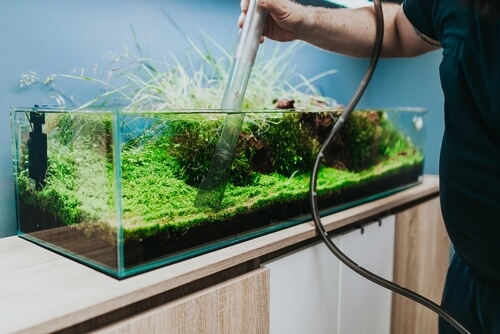
The ideal tank for one Zebra Pleco is a minimum of 30 gallons because you also need to account for setting up powerheads to create a good flow, as well as the addition of driftwood and cave structures. Simply put, there’s more than meets the eye to the needs of these little fish.
Environment
In the wild the Zebra Pleco clings to rocks and crevasses in the fast-flowing Xingu River, a tributary of the Amazon. Therefore, be prepared to set up a similar rocky habitat in your tank. It’s a good idea to build structures out of rocks and driftwood and include spots where your Pleco can sneak away and hide.
Some aquarists include bits of PVC piping in their tank. Whilst these are not the most natural-looking solution, many Pleco species do love to hide in them.
Author’s Note: A sandy substrate is really important. Plecos have sensitive stomachs and they will hurt themselves on a gravel substrate. Alternatively, if you don’t like the look of sand, you can use smooth stones and pebbles.
Plants
Plants are a must for any Amazonian tank, and they make really good hiding places for shy Plecos as well as for other, smaller, schooling tankmates like Tetras. A list of good Amazonian and other plants includes:
- Amazon Pennywort
- Amazon Sword
- Water Milfoil
- Guppy Grass
- Echinodorus
- Anubias
- Amazon Frogbit
Tankmates
Zebra Plecos can get on with other species of Plecos, such as the Green Phantom Pleco, Royal Pleco, or Bue Phantom Pleco. Therefore, if you want to set up a Pleco tank, they can be a great addition.
However, the Zebra Pleco also works with other Amazonian species, providing they are peaceful and will not harass your Pleco. Due to its small size and gentle nature, the Zebra Pleco makes an ideal tankmate for fish like the discus, which is equally shy and relatively sensitive. The two will simply lead each other alone!
However, these guys can also work with an Amazonian angelfish tank, as they occupy different territories and even though angelfish are semi-aggressive, the conflict will therefore be rare. In general – amazonian species are a good rule of thumb, as they generally require the same conditions.
Just avoid anything from acidic, blackwater streams – Zebra Plecos prefer a neutral pH which won’t be a good match for lovers of acidic, soft water like certain tetra species. A list of good Amazonian and other small tankmates includes:
- Neon Tetra
- Red Phantom Tetra
- Cardinal Tetra
- Otoclincus Catfish
- Harlequin Rasbora
- Zebra Danio
Flow System
In their natural habitat, these fish live in fast-flowing water. Simply put, they will get stressed and anxious if you can’t replicate these conditions at home. In fact, slow-moving water is one of the main ways Plecos can develop disease. Why is this? Stagnant water that isn’t altered enough or doesn’t have enough circulation makes it really easy for bacteria, nitrates, nitrites, ammonia, and other toxins to build up.
You can get a good flow going with powerheads which are, essentially, features that suck in water at one end and pump it out at another. You should be able to find these from a large aquatics store, but if not, you can also order them online.
Filtration
How does filtration differ from a flow system? A flow system is about how strongly the water moves around within the tank. A filter, meanwhile, filters toxins from the water using a sponge or canister. As Pleco tanks can get quite big, use a canister or HOB (hang on back) filter. The smaller, weaker sponge filters might be ok if you are just keeping one Zebra Pleco, but for anything more, it’s good to have something more powerful.
That being said, the filter flow rate doesn’t have to be that strong. Water movement and circulation are as important, if not more so, to these fish. That doesn’t mean you should skimp on a filter. It just means it doesn’t have to be super powerful – only 5x tank capacity per hour is plenty – and in fact, it’s best if it isn’t, as these fish aren’t strong swimmers.
Feeding Zebra Plecos
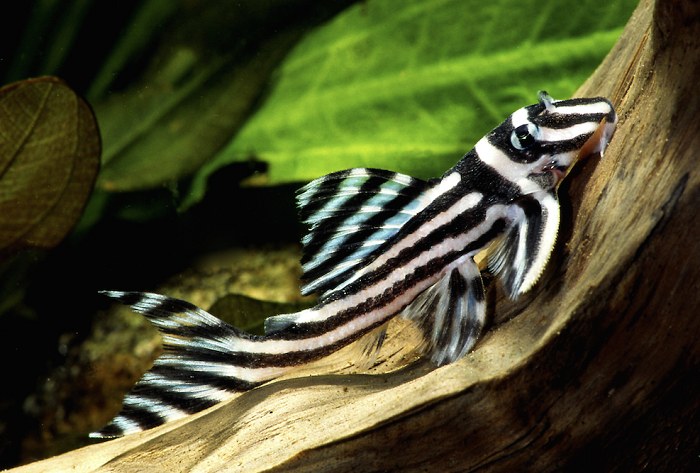
As an algae eater, it’s best to use algae wafers as the basis of your Pleco’s diet. You can allow these wafers to sink to the bottom of the tank where your Pleco will happily gobble them up. You can feed 1-2 wafers per day depending on how hungry your fish seems.
However, what else do these Plecos eat? Some Plecos are actually able to digest driftwood, such as the Green Phantom Pleco. The Zebra Pleco is a little less reliant on driftwood than other species like this. However, it’s still important to include some in the tank as by clasping onto wood with their sicker mouths, Plecos get an important source of fiber.
Author’s Note: If you want to enrich your Pleco’s diet, it’s also great to offer vegetables. They like zucchini, a bit of blanched sweet potato, peas, or lettuce leaves.
Behavior And Temperament
To sum it up, the temperament of these fish can be described as peaceful, passive, and shy. However, there is so much more to them than that! The Zebra Pleco is a nocturnal species, meaning it is more active at night. If you observe the tank around dawn and dusk, as well, you may be able to catch them in the middle of feeding or other activity.
It is in fact possible to keep them with fish that are active during the daytime such as Barbs if you want a variety of fish behavior in your tank. In fact, these different habits can minimize competition between fish.
During the day these fish have the habit of hiding in crevasses and in piping (if you have added any for them). However, at night when they come out to feed, you will find that they enjoy moving gently along the bottom, clinging to rocks and driftwood, or even hanging out on the side of the tank. These fish do enjoy exploring, and once they feel bold enough, you will see them out in the open pretty often.
Pests And Diseases
You may occasionally hear that Plecos are immune to some or even most fish diseases. It may be true that there are some diseases they don’t get very often, such as Hexamita, or swim bladder disease, you will find that they are not totally immune to all diseases. The following section breaks down some of the most common – and how you can easily prevent and treat them.
Pleco White Fungus
White fungus is a fungus that can appear as white circular patches on the body of your Pleco fish. As its name suggests, it can be simply treated with saltwater baths and other antifungal treatments.
However, the appearance of this disease means that the tank quality probably isn’t good enough for your Pleco. Zebra Plecos need a strong flow of water; this is why you include powerheads in the tank. In stagnant or slow-moving water, therefore, they are much more likely to develop this and other fungal infections.
Pleco Mouth Infections
The mouth is a sensitive area of the Pleco and if tank conditions are not good enough, it is often one of the first places you will see infection. In fact, Pleco mouth fungus can even spread to other parts of the body.
Plecos can also develop bacterial infections in their mouths, which may take the form of mouth ulcers. These should be treated with antifungal and antibacterial treatments respectively. It’s also best to quarantine the fish in a separate tank so that the medication you are using does not affect healthy fish.
Author’s Note: Take all mouth infections as a sign that the water quality may not be very good! These sensitive fish are often one of the first to show signs of stress in a bad environment.
Breeding

It’s relatively tricky to breed Zebra Pleco fish in captivity. Indeed, this is one of the reasons this fish is on the expensive side. However, if you do want to give it a go, this guide will give you a rough breakdown of the process.
How Do Pleco Fish Mate?
How do Pleco fish mate? In their natural habitat, Pleco fish often live near rocky outcrops that contain caves and other hollow spaces where they can take shelter. It is also in these caves that they lay their eggs. You will see the female swim into a cave-like structure and lay eggs; often, however, it is the male fish who chases her in there.
Zebra Pleco Mating Process
After the female has laid her eggs and the male has sprayed his milt over them, you will realize why Plecos are one of the most fascinating fish to breed. This is because the males actually make very good parents and will stay near the mouth of the cave and fan the eggs with their fins.
Even after the fry hatch, the male will stay nearby and guard them. Plecos do not eat their young the way some other species of fish do. It is only when the fry is big enough to leave the cave and start exploring freely on its own that you need to remove the male.
However, this form of the mating process means it is crucial you set up a separate breeding tank. Pleco males and fry can get harassed by other tankmates if you leave the process to happen in a shared tank. A good breeding tank must include:
- Some aquatic plants hide in
- Some sort of cave or another sheltered spot to encourage egg laying
- Filtration
- It’s also beneficial to make sure it’s relatively large, a minimum of 20 gallons – so as to accommodate the fry as they grow.
How Many Eggs Do Female Zebra Plecos Lay?
The female Zebra Pleco actually lays relatively few eggs compared to some other species of fish – only between 10-20. This is why it makes it so hard to breed this fish in captivity.
Looking After The Fry
Zebra Pleco fry are often born with an egg yolk sac attached to the underside of their bodies. As indicated by the size of the eggs, they are relatively large and hardy. You may see them stay in the cave for a while after they hatch, and at this stage, they get all the nutrients they need from the yolk sacs they are attached to.
After 2-3 days, start feeding them on infusoria or baby brine shrimp. Infusoria is a purpose-created mixture of aquatic invertebrates that small fish and fry would eat in the wild. Baby brine shrimps, meanwhile, are smaller than adults and easier for growing fish to digest.
Feeding more than once a day will help these fish grow to adulthood and ensure survival. Scientists have found feeding twice a day helps maintain optimum growth.
Final Thoughts
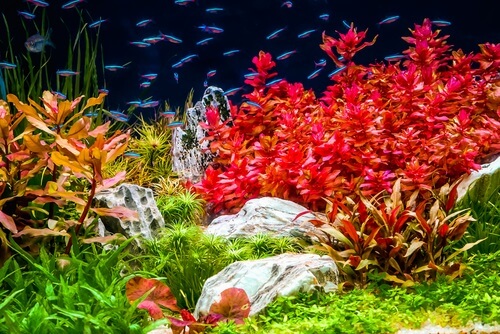
Zebra Plecos are one of the most unusual and difficult-to-find Plecos. However, if you manage to get hold of one you really will find them very easy to take care of, contrary to their exotic appearance. The only thing to remember is the fact they need a strong water flow. However, if you manage to set things up correctly, you will find these are rewarding and surprisingly long-lived fish that you will enjoy having in your tank for many years to come.


